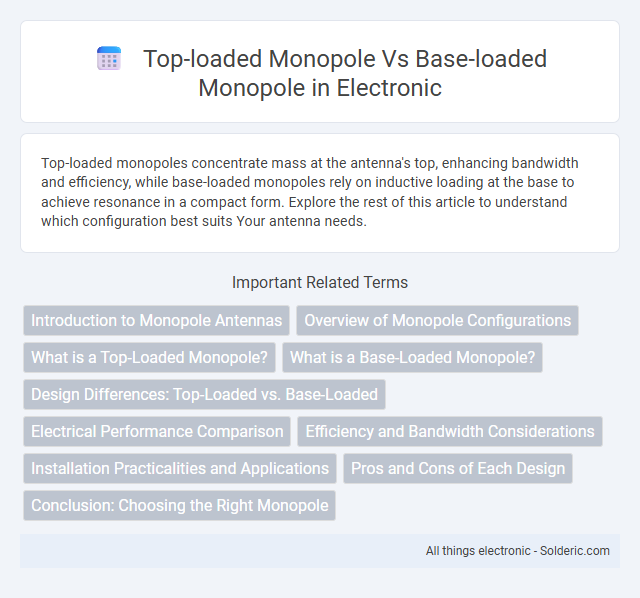Top-loaded monopoles concentrate mass at the antenna's top, enhancing bandwidth and efficiency, while base-loaded monopoles rely on inductive loading at the base to achieve resonance in a compact form. Explore the rest of this article to understand which configuration best suits Your antenna needs.
Comparison Table
| Feature | Top-Loaded Monopole | Base-Loaded Monopole |
|---|---|---|
| Loading Position | Capacitive hat or coil at the top | Inductive coil at the base |
| Electrical Length | Effectively increased by top loading | Effectively increased by base loading |
| Physical Height | Often shorter than a full quarter wavelength | Can be significantly shorter than a quarter wavelength |
| Impedance Matching | Easier to match with standard feedlines | May require complex matching network |
| Bandwidth | Generally wider bandwidth | Narrower bandwidth due to base loading coil |
| Efficiency | Higher efficiency, lower losses | Lower efficiency due to coil losses |
| Applications | Mobile, portable antennas, HF/VHF operation | Compact installations with space constraints |
| Construction Complexity | Moderate, requires top loading element | Complex coil design and tuning at base |
Introduction to Monopole Antennas
Monopole antennas operate by using a single conductive element, typically a quarter wavelength long, mounted above a ground plane to transmit and receive radio waves efficiently. Top-loaded monopole antennas feature additional capacitive elements at the antenna's tip, enhancing electrical length and bandwidth without increasing physical height. Base-loaded monopoles incorporate inductive components at the feed point, allowing shorter antenna designs but generally with narrower bandwidth and reduced efficiency compared to top-loaded variants.
Overview of Monopole Configurations
Top-loaded monopoles feature an extended capacitive element at the antenna's apex, enhancing effective electrical length and improving radiation efficiency in limited physical height scenarios. Base-loaded monopoles incorporate inductive loading coils near the ground connection to achieve resonance while maintaining compact antenna structure. Both configurations optimize monopole performance through different impedance-matching techniques suited for space-constrained applications.
What is a Top-Loaded Monopole?
A top-loaded monopole antenna features a vertical radiating element with additional inductive loading at the top, enhancing its electrical length without increasing physical height. This design improves radiation efficiency and bandwidth by compensating for the short physical size, making it ideal for limited space installations. Top-loading involves a capacitance hat or horizontal wires, which effectively increase the antenna's resonance at lower frequencies compared to base-loaded monopoles.
What is a Base-Loaded Monopole?
A base-loaded monopole is a type of vertical antenna where the inductive loading coil is placed at the base to electrically lengthen the antenna for better resonance on lower frequencies. This design allows a physically shorter antenna to perform like a longer one, improving transmission efficiency without increasing overall height. You benefit from compact installation while maintaining effective signal propagation, especially in constrained spaces.
Design Differences: Top-Loaded vs. Base-Loaded
Top-loaded monopole antennas feature a capacitive hat or loading coil near the antenna's apex, enhancing electrical length without increasing physical height, which improves efficiency in limited spaces. Base-loaded monopoles incorporate a loading coil at the antenna's base, concentrating inductive reactance near the ground plane to achieve resonance while maintaining a compact structure. Your choice between top-loaded and base-loaded designs depends on installation constraints and performance priorities, as each approach optimizes antenna tuning differently.
Electrical Performance Comparison
Top-loaded monopoles exhibit improved radiation efficiency and a higher current distribution near the antenna's top, enhancing bandwidth and gain compared to base-loaded monopoles. Base-loaded monopoles generally present a more compact design but suffer from increased resistive losses and reduced radiation efficiency due to the loading coil placement at the base. The trade-off between physical height and loading method directly influences the antenna's impedance matching and overall electrical performance in various frequency bands.
Efficiency and Bandwidth Considerations
Top-loaded monopole antennas typically offer improved efficiency by effectively increasing electrical length without requiring a physically taller structure, resulting in better radiation performance at lower frequencies. Base-loaded monopoles, while more compact, often suffer reduced efficiency due to the lossy loading coil and exhibit narrower bandwidth because of higher Q factors. Optimizing bandwidth involves balancing the loading method, with top-loading generally providing wider bandwidth and enhanced radiation efficiency compared to base-loaded designs.
Installation Practicalities and Applications
Top-loaded monopole antennas simplify installation with a shorter physical length and easier mounting, making them ideal for limited space or rooftop applications. Base-loaded monopoles require a robust grounding system and more complex installation but offer better performance in restricted heights by using coil inductors to electrically lengthen the antenna. Your choice depends on site constraints and desired signal efficiency, balancing ease of setup against optimal transmission quality.
Pros and Cons of Each Design
Top-loaded monopole antennas offer enhanced radiation efficiency and improved bandwidth due to their increased effective electrical length, making them ideal for compact spaces, but they may be structurally more complex and heavier. Base-loaded monopoles require less physical height and simpler support structures, which can reduce installation costs and complexity, but they often suffer from lower radiation efficiency and narrower bandwidth compared to top-loaded designs. Your choice depends on balancing the need for performance versus installation constraints, with top-loading favored for better signal quality and base-loading suitable for cost-effective, space-limited setups.
Conclusion: Choosing the Right Monopole
Top-loaded monopoles offer enhanced radiation efficiency and reduced physical height, making them ideal for limited space installations and improved bandwidth. Base-loaded monopoles provide simpler design and better mechanical stability but often require more vertical space and result in reduced efficiency. Selecting the right monopole depends on balancing physical constraints, performance needs, and installation environment for optimal antenna operation.
top-loaded monopole vs base-loaded monopole Infographic

 solderic.com
solderic.com